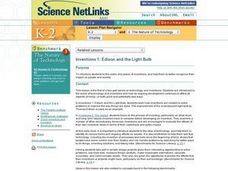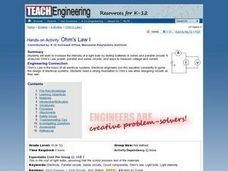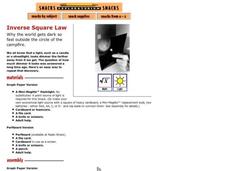Curated OER
Comparing Light Bulbs
Third graders learn how light bulbs are different and which are more cost efficient. In this energy and efficiency lesson, 3rd graders compare the cost of a light bulb and understand that its lifetime is important to their choice.
Curated OER
Inventions 1: Edison And The Light Bulb
Students examine the realm and power of inventions, and recognize their impact on people and society. Small groups pretend to have been hired by Edison to make special posters that advertise the uses and benefits of the light bulb.
Curated OER
Let's Light up a Light Bulb
Third graders investigate electricity. In this electricity lesson, 3rd graders observe a familiar battery-operated toy and brainstorm reasons why and how the battery works. Students work in pairs to explore batteries, bulbs, and wires,...
Curated OER
Edison and the Light Bulb
Students explore the impact of inventions on society, specifically Edison and the light bulb. In this technology lesson, students use online resources and listen to a story about Edison to develop an understanding of how the light bulb...
Bonneville
Three Ways to Generate Electricity
Get your hands on electricity. Pupils investigate magnetic fields and make the connection to generators in the fourth instructional activity in a series of six lessons on wind versus solar energy. Learners use a small electric motor as a...
Teach Engineering
Light vs. Heat Bulbs
Careful, that light bulb is hot! Compare heat and light energy using a simple light bulb. The exercise addresses energy conservation and presents actual calculations to determine the most cost-effective light bulb.
Curated OER
Inventions 1: Edison and the Light Bulb
Students are introduced to the realm and power of inventions, and help them to better recognize their impact on people and society.
Curated OER
The Technology of Light
Students study the different types of light bulbs. In this exploratory lesson students complete several activities and create an electrical circuit.
Curated OER
Ohm's Law I
Students work to increase the intensity of a light bulb by testing batteries in series and parallel circuits. They analyze Ohm's Law, power, parallel and series circuits, and ways to measure voltage and current.
Starry Night Education
The Stars
Three astronomy activities in one resource! Here you will find one hands-on activity, one demonstration, both with discussion questions, and one activity worksheet. During these lessons young scientists discuss how stars are different,...
Curated OER
Lights Light Up My Life
Middle schoolers conduct an investigation. For this energy conservation lesson, students observe and make predictions about fluorescent and incandescent light bulbs. Working in groups, middle schoolers conduct an investigation to...
Curated OER
Let There Be Light
Fifth graders explore electricity. For this electricity lesson, 5th graders experiment with open and closed circuits. Students determine how to properly connect a battery and bulb to illuminate the bulb.
Exploratorium
Oil Spot Photometer
Are these two light sources the same? Groups use a white card and a little cooking oil to create a photometer that allows for the comparison of two lights. The Inverse Square Law provides a way to calculate the actual difference in...
Exploratorium
Inverse Square Law
The inverse square law is revealed when your class participates in this activity. They move a graph paper or perfboard square back and forth in a square of light to see how the intensity changes. You will definitely want to add this...
Curated OER
Simple Circuit
In this circuits activity, students follow directions on how to make a light bulb light and answer questions about it. Students answer 1 question about an insulator and 1 about a conductor.
Curated OER
Signaling
In this signaling worksheet, learners follow directions to make a circuit involving batteries, light bulbs, wires and more. Students then try to make morse code signals with their circuit.
Curated OER
Light 3: All Those Seeing Color, Say Eye!
Middle schoolers explore the nature of light. They use on-line articles and a worksheet to explore the roles of the eye and brain in the perception of color. They draw and label a diagram illustrating the movement of light.
Curated OER
Solar Kit Lesson #3 Parts of a Solar Panel - Part I
A solar cell is similar to a rechargeable battery in many ways. Science lab groups connect each in a series circuit to run a mini motor and then compare and contrast them by answering questions and completing a Venn diagram. This is an...
Curated OER
Let's Light Up a Light Bulb!
Third graders investigate the concept of how electricity works in the lighting of a light bulb. They construct a circuit in order to follow the path of electricity and test how it can travel in a wire system. Then the light bulb is lit...
Curated OER
Being Shadowed
What causes a shadow to appear? Have kindergartners and first graders explore shadows with a fun science activity. After reading a short paragraph about light sources, they draw a shadow for a little girl based on the location of the...
Teach Engineering
Lighting in My Classroom Survey
How much energy does it take to light a room? Class members calculate the total wattage it takes to light the classroom. Through calculations, responsible scientists determine the cost of energy for the year, then figure out how much...
National Wildlife Federation
Wherefore Art Thou, Albedo?
In the sixth lesson in a series of 21, scholars use NASA data to graph and interpret albedo seasonally and over the course of multiple years. This allows learners to compare albedo trends to changes in sea ice with connections to the...
New Jersey Historical Commission and New Jersey Council for the Humanities
Thomas Edison: The Wizard of Menlo Park
What would change in your daily life due to a power outage? Here, learners explore the inventions brought to us by the one and only, Thomas Edison, and imagine a day without them. Scholars take part in a grand conversation and write a...
Curated OER
Light 2: The Lighter Side of Color
Students explore light and color, including how colors are mixed to produce new colors, how light is filtered, and how light is reflected off of surfaces.

























